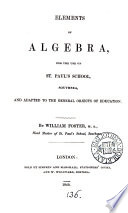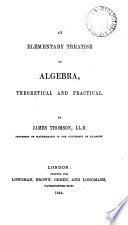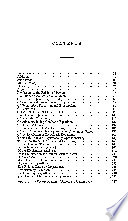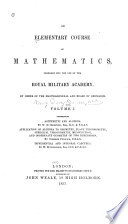 | William Foster - 1840 - 92 pages
...If equals be divided by the same, the quotients will be equal. RULE I. 7. Any term may be transposed from one side of an •equation to the other by changing its sign. Ex. 1. If x + 3=7 then j=7— 3. Ex. 2. If4x-8=3x+20 then-te— 3*— 20-1-8. PROOF. The same quantity... | |
 | John D. Williams - Algebra - 1840 - 216 pages
...proportion - =- ; therefore, (18, Cor. 1,) ad=be.. RULE I. Any term may be transposed or transferred from one side of an equation to the other, by changing its signs.Thus, if z4-3=7 ; then will x=7— 3, or z=4. And, if x— 4+6=8 ; then will z=8+4— 6=6. Also,... | |
 | James Thomson - 1844 - 328 pages
...to the other member and changing its sign. Hence, 25. A quantity may be transposed from one member of an equation to the other, by changing its sign. It is plain, also, that any number of terms may be transposed in a similar way at a single operation. Thus,... | |
 | Scottish school-book assoc - 1845 - 444 pages
...following rules for the resolution of equations can be derived : — 63. RULE 1. Any quantity can be taken from one side of an equation to the other, by changing its sign. This rule is derived from axioms 1st and 2d, as will appear evident from the following example : Let... | |
 | John Bonnycastle - 1848 - 334 pages
...If of equals the same root be extracted, the roots are equal. Rule 1. Any quantity may be transposed from one side of an equation to the other, by changing its sign from + to — , or from — to +, and the equation will still subsist, as is evident from axioms 1... | |
 | George Roberts Perkins - Algebra - 1848 - 234 pages
...from one side of an equation to the other, we must observe this У RULE. Лny term may be transposed from one side of an equation to the other, by changing its sign. EXAMPLES. x+6 5x 1. Clear the equation - - — \-26=- — \-2 effractions, and transpose the terms... | |
 | John William Colenso - Algebra - 1849 - 262 pages
...156, or 6x -f 4x + 3z = 156 ; hence 13z = 156, and x = \*/- = 12. 39. A quantity may be transferred from one side of an equation to the other by changing its sign, without destroying the equality expressed by it. Thus if х-а=у+Ъ, adding a to each side of the... | |
 | John Bonnycastle - Algebra - 1851 - 288 pages
...the most useful and necessary of which are the following:—f CASE I. Any quantity may be transposed from one side of an equation to the other, by changing its sign ; and the two members, or sides, will still be equal. Thus, if x + 3 = 7 ; then will x = 7 — 3, or... | |
 | Royal Military Academy, Woolwich - Mathematics - 1853 - 476 pages
...founded on the preceding axioms, apply to all classes of equations. 85. A quantity may be transposed from one side of an equation to the other by changing its sign from + to — , or from — to +, without destroying the equality. Thus if x + 3 = 17, then subtracting... | |
 | George Boole - Logic, Symbolic and mathematical - 1854 - 442 pages
...give the equation x - z = y, (8) which must therefore be a deduction from (7). Thus a term z has been removed from one side of an equation to the other by changing its sign. This is in accordance with the algebraic rule of transposition. But instead of dwelling upon particular... | |
| |